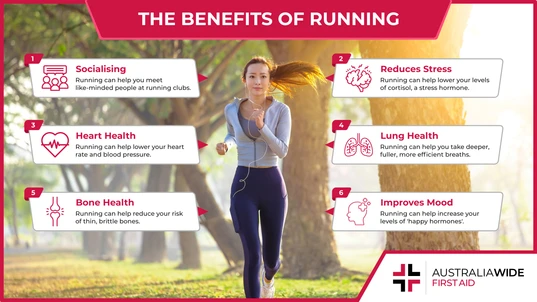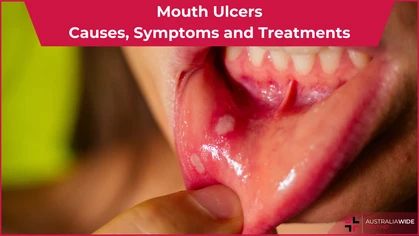The Benefits of Running

General Health-Related

Running is one of Australia's most popular physical activity pursuits. Not only is it accessible to a wide range of people, it can help participants improve their cardiovascular fitness, muscular and bone strength, and markers of good emotional health.
The Australian Broadcasting Corporation (ABC) recently reported on a GP, Dr Jennie Wright, who prescribed running as a treatment for one of their patients. The patient, Steve Connelly, had been suffering from symptoms of depression after undergoing an operation to receive a pacemaker. Three years and over 300 kilometres later, Steve is now an accomplished half-marathoner, and his physical and mental health have never been better. Steve's dramatic transformation is a testimony to the numerous and often invaluable benefits that running can provide. With running season upon us, it is worthwhile to take a look at these benefits - they may just persuade you to lace up your own joggers and hit the pavement!Running can Improve your Cardiovascular Fitness
Your cardiovascular health refers to how well your heart and lungs can supply blood, and the oxygen and nutrients therein, to your muscles and organs. The heart is like any other muscle - the more physical stress you put it under, the more it adapts and becomes stronger. As such, if you run regularly, you can train your heart to pump blood around your body using less beats and under lower pressure. People with low heart rates and blood pressure, in turn, have a lower risk of cardiovascular disease. In fact, a 2014 study by the Journal of the American College of Cardiology found that persistent runners have a 50% lower risk of cardiovascular mortality, compared to people who never run. Running can similarly stave off cardiovascular disease by lowering cholesterol, a fat-like substance that can build up in the walls of arteries and block them. In further service of the cardiovascular system, regular running can help strengthen your respiratory muscles to facilitate deeper, fuller, and more efficient breaths. Regular running can also help your lungs grow more alveoli and capillaries, thereby allowing more oxygen to get to your muscles quicker.Running can Improve your Muscular Strength
The heart is not the only muscle that running can strengthen. Provided you are consuming the correct amount of protein and calories, regular running can also strengthen the muscles in your lower body. According to Dr. Michael Jordan, a physical therapist based in Alexandria, Virginia, building muscle boils down to a simple equation of "stress plus recovery equals adaptation". Stress occurs whenever you work your body harder than it's used to, which causes the tissues in your muscles to break down and then build back stronger during periods of recovery. During running, your body impacts the pavement repeatedly, and so it can be considered a form of stress. In particular, your glutes and carves help propel you forward and engage your hip flexors and hamstrings, thereby stabilising and strengthening your entire torso. Muscular strength enhances overall health. Firstly, it can help increase your balance, flexibility, and bone density, all of which can diminish your risk of falls, breakages, and chronic pain. Likewise, building strength can help you burn calories and maintain a healthy fat-to-muscle ratio, which itself is important to reducing the risk of Type 2 diabetes, stroke, and many other chronic conditions.Run can Improve your Mood and Reduce Stress
As well as facilitating good physical health, running plays a vital role in boosting your emotional wellbeing. Firstly, running is well regarded for its ability to reduce anxiety and depression. When you run, blood circulation to the brain is increased, including the part that responds to stress and enhances your mood. This subsequently causes a temporary change that improves your reaction to stressful situations. Likewise, after you run, endocannabinoids are released in your body. Endocannabinoids are naturally occurring neurotransmitters that scientists believe play a key role in contributing towards homeostasis, the maintenance of optimal conditions within the body. As such, research suggests that endocannabinoids help regulate the function of metabolism, reproduction, sleep, memory, mood, and inflammation and other immune responses. According to the Sleep Foundation, sufficient sleep in itself is important to good emotional wellbeing, as it facilitates the brain’s “consolidation of positive emotional content”. Running can also have a dramatic impact on self-confidence, as runners often set themselves goals in their training. A study conducted out of Columbia University found that setting and attaining ambitious goals has an impact on your sense of happiness and gratification, which subsequently raises your confidence.Running can Help you Socialise
Contrary to sports like golf, sailing, and water skiing, running requires very little equipment, and so it is a sport that just about anyone can become involved in. In fact, it is one of Australia's largest and most popular physical activity pursuits, with data from Sport Australia and Athletics Australia estimating that 3 million Australians participate in running. Further, to hold themselves accountable to their training goals, many runners organise themselves into ad hoc and more formal running groups, such as the Pat Carroll Running Group based in Brisbane. As such, running provides participants with a fantastic opportunity to meet and befriend like-minded people. Forging friendships can, in turn, positively impact your emotional wellbeing. For instance, studies show that adults who have strong social connections have a reduced risk of many chronic health conditions, including depression and high blood pressure, and are likely to live longer than peers who have fewer connections. This is because good friends increase your sense of belonging and self-worth, they help you cope with trauma, and they encourage you to change unhealthy lifestyle habits. And when it comes to running, research shows that running with others can help improve your speed and stamina, as the conversational back-and-forth can help distract you from the actual running.
Being in nature has numerous positive impacts on our physical and emotional wellbeing. Humans are genetically programmed to find natural elements, like trees and water, engrossing. As such, they can help imbue feelings of calm and vitality.
Running can Help you Connect with Nature
As we mentioned earlier, running is an incredibly accessible sport, as you do not need much equipment to get started. On top of that, you do not need to travel to any special training facilities to get some kilometres under your belt. Rather, you can just head over to your nearest oval, hiking trail, or shared pathway. This is another benefit of running - it can help connect you to nature. According to the University of Minnesota, being in nature can reduce feelings of anger, fear, and stress, while increasing positive feelings like calmness and harmony. This subsequently improves physical markers of health like blood pressure, heart rate, and muscle tension. Being in nature has also been shown to foster a greater sense of empathy for others and our environment, as well as facilitating a break from screen technology, and renewing our ability to pay attention to new tasks. Likewise, being in nature provides incidental exposure to the sun's ultraviolet B (UVB) radiation, which is an important source of vitamin D. Vitamin D, in turn, helps the body absorb calcium from food to support healthy bones, and thereby stave off the development of osteoporosis and other bone conditions. More information about the importance of good bone health can be found in our Resource Library.Conclusion
GPs across Australia are starting to prescribe running as a social alternative for treating a range of physical and mental conditions. This is for good reason, as running has been shown to improve one's cardiovascular fitness, muscular strength, and positive feelings of harmony, happiness, and self-confidence. However, just like any other physical activity, running can cause injuries, such as soft tissue damage. To find out how to prevent, identify, and manage these injuries from deteriorating further, head to one of our First Aid courses.
Originally published at
https://www.australiawidefirstaid.com.au/resources/the-benefits-of-running
as part of the Australia Wide First Aid Articles Library









